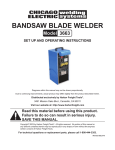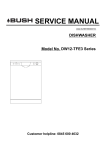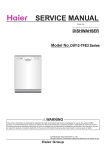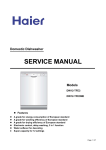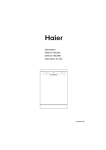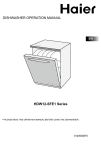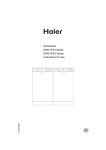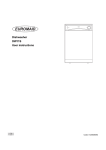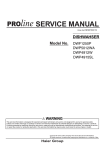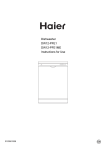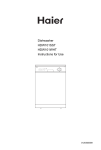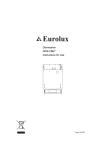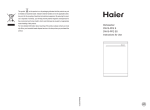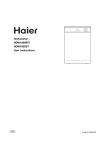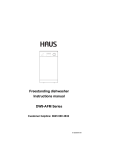Download SERVICE MANUAL
Transcript
SERVICE MANUAL Order No.REF0905S002V0 DISHWASHER Model No. DW9-AFM Series Customer helpline: 0845 600 4632 Service Manual Model No: DW9-AFM Series Issue Rev. 1-1. Contents 1-1. Contents .......................................................................................................................................... 1 1-2. Features ........................................................................................................................................... 3 1-2-1. A grade for energy consumption of European standard................................................ 3 1-2-2. B grade for washing efficiency of European standard.................................................... 3 1-2-3. Bgrade for drying efficiency of European standard......................................................... 3 1-2-4. Water softener for descaling ................................................................................................ 3 1-3. How to read this Service Manual ................................................................................................. 4 1-4. Safety Precaution ........................................................................................................................... 5 1-4-1. At time of delivery................................................................................................................... 5 1-4-2. During installation.................................................................................................................... 5 1-4-3. During normal use ................................................................................................................... 5 1-5. Installation ....................................................................................................................................... 6 1-5-1. If your family includes children ............................................................................................. 6 1-5-2. If a fault occurs........................................................................................................................ 6 1-5-3. When disposing of old appliances ...................................................................................... 6 1-5-4. Positioning the appliance...................................................................................................... 6 1-5-5. Leveling the appliance.......................................................................................................... 6 1-5-6. Cold water connection ......................................................................................................... 6 1-5-7. Hot Water Connection........................................................................................................... 7 1-5-8. Electrical Connection ............................................................................................................ 7 1-5-9. Drain hose connection .......................................................................................................... 8 1-6.Tools.................................................................................................................................................. 9 1-7. Dissemble and assemble procedure......................................................................................... 11 1-7-1. Water pressure switch disassembly .................................................................................... 11 1-7-2. Detergent dispenser disassembly....................................................................................... 14 1-7-3. Baseboard disassembly ....................................................................................................... 14 1-7-4. Left/right side plate and baseboard disassembly .......................................................... 15 1-7-5. Side panel disassembly ........................................................................................................ 15 1-7-6. Sump disassembly ................................................................................................................. 16 1-7-7. Water softer disassembly ..................................................................................................... 18 1-7-8. Heater disassembly............................................................................................................... 19 1-8. Parts and Functions..................................................................................................................... 21 1-8-1. Close-up view (control panel) ............................................................................................ 21 1-8-2. Dishwasher interior ................................................................................................................ 21 1-9. How to fill the salt......................................................................................................................... 22 1-9-1. Salt ........................................................................................................................................... 22 1-9-2. Loading the salt into the container ................................................................................... 22 1-9-3. Adjusting salt consumption ................................................................................................. 22 1-10. How to fill rinse aid and detergent dispenser........................................................................ 24 1-10-1. How to fill rinse aid .............................................................................................................. 24 1-10-2. How to fill detergent dispenser......................................................................................... 24 1-11. Loading the dishwasher............................................................................................................ 25 Page 1 of 44 Service Manual Model No: DW9-AFM Series Issue Rev. 1-11-1. How to use the lower rack................................................................................................. 25 1-11-2. How to use the upper rack................................................................................................ 25 1-11-3. Shelf ....................................................................................................................................... 26 1-12. Turning on the Appliance.......................................................................................................... 27 1-12-1. Switching the dishwasher ON ........................................................................................... 27 1-12-2. End of programme ............................................................................................................. 27 1-13.Wash Cycle Table........................................................................................................................ 28 1-14. How to keep your dishwasher in shape.................................................................................. 30 1-14-1. After Every Wash ................................................................................................................. 30 1-14-2. Remove the plug ................................................................................................................ 30 1-14-3. No solvents or Abrasive Cleaning Products ................................................................... 30 1-14-4. Moving the Appliance ....................................................................................................... 30 1-14-5. Seals....................................................................................................................................... 30 1-14-6. When You Go on Holiday.................................................................................................. 30 1-15. Clean and mentenance.............................................................................................................. 31 1-15-1. Overall condition of appliance........................................................................................ 31 1-15-2. Dishwasher salt .................................................................................................................... 31 1-15-3. Filters ...................................................................................................................................... 31 1-15-4. Spray arms............................................................................................................................ 31 1-16. Maintenance Services and Trouble Shooting........................................................................ 32 1-16-1. Maintenance services........................................................................................................ 32 1-16-2. Trouble shooting .................................................................................................................. 32 1-17. Analysis of the common breakdowns..................................................................................... 35 1-17-1. Door switch trouble............................................................................................................. 35 1-17-2. Water supply trouble .......................................................................................................... 36 1-17-3. Drain pump trouble ............................................................................................................ 37 1-17-4. Heating element trouble ................................................................................................... 38 1-17-5. Water overflow trouble ...................................................................................................... 39 1-17-6. Power supply trouble.......................................................................................................... 40 1-17-7. Leak trouble ......................................................................................................................... 41 1-19. Technical data............................................................................................................................. 42 1-20. Circuit Diagram........................................................................................................................... 43 Page 2 of 44 Service Manual Model No: DW9-AFM Series Issue Rev. 1-2. Features 1-2-1. A grade for energy consumption of European standard 1-2-2. B grade for washing efficiency of European standard 1-2-3. Bgrade for drying efficiency of European standard 1-2-4. Water softener for descaling Page 3 of 44 Service Manual Model No: DW9-AFM Series Issue Rev. 1-3. How to read this Service Manual The symbol on the product or on its packaging indicates that this product may not be treated as household waste. Instead it shall be handed over to the applicable collection point for the recycling of electrical and electronic equipment. By ensuring this product is disposed of correctly, you will help prevent potential negative consequences for the environment and human health, which could otherwise be caused by inappropriate waste handling of this product. For more detailed information about recycling of this product, please contact your local city office, your household waste disposal service or the shop where you purchased the product. Warning: A “warning” is used when there is danger of personal injury. Caution: A “caution” is used when there is danger that the reader, through incorrect manipulation, may damage equipment, loose data, get an unexpected result or has to restart (part of) a procedure. Notice: A “notice” provides information that is not indispensable, but may nevertheless be valuable to the reader. Page 4 of 44 Service Manual Model No: DW9-AFM Series Issue Rev. 1-4. Safety Precaution NOTICE Carefully read the instructions contained in this manual, as they provide important information which is essential to safe and proper installation, use and maintenance of the appliance. This appliance complies with the following EEC directives: - 73/23/EEC of 19/02/73 (Low Voltage) and subsequent modifications; - 89/336/EEC of 03/05/89 (Electromagnetic Compatibility) and subsequent modifications. 1-4-1. At time of delivery Check packaging and dishwasher immediately for signs of transport damage. If the appliance is damaged, do not put it into use but contact your supplier or customer service without delay. Please dispose of packaging materials properly. 1-4-2. During installation Site the dishwasher and connect it up in accordance with the installation instructions. The dishwasher must not be connected to the electricity supply while installation is being carried out. Ensure that the domestic wiring is properly earthed. The mains electricity supply must conform to the details shown on the dishwasher nameplate. Do not connect the dishwasher to the electricity supply via an extension cable. Built-under and built-in appliances should always be installed under a continuous work surface which is attached to the adjacent cupboards, in order to ensure that the appliance is entirely stable. After the appliance has been installed, the mains plug should still be easily accessible. Not on all models: The plastic housing on the water inlet contains an electrically operated valve. The connecting wires are inside the inlet hose. Do not cut through this hose and do not immerse the plastic housing in water. During installation, the power supply cord must not be excessively or dangerously bent or flattened. 1-4-3. During normal use The dishwasher must only be used by adults for the washing of household dishes and cooking utensils. This appliance cannot be installed outdoor, not even if the area in which it is installed is covered by a roof; it is also very dangerous to leave it exposed to the rain and elements. Do not place any heavy objects or stand on the door when it is open. The appliance could tip forward. The water inside the dishwasher is not suitable for drinking. Do not use solvents of any kind inside your dishwasher. They could cause an explosion danger. Open the door very carefully if the dishwasher is operating. There is a risk of water squirting out. Do not touch the heating element during or after a wash cycle. Fundamental rules to follow when using the appliance: Never touch the dishwasher when barefoot or with wet hands or feet; We discourage the use of extension cords and multiple sockets; If the appliance is not operating properly or maintenance must be performed, disconnect the appliance from the power supply. Page 5 of 44 Service Manual Model No: DW9-AFM Series Issue Rev. 1-5. Installation 1-5-1. If your family includes children The appliance is not intended for use by young children or infirm persons without supervision. Young children should be supervised to ensure that they do not play with the appliance. Keep detergents out of the reach of children, who must also be kept away from the dishwasher when it is open. 1-5-2. If a fault occurs If the appliance malfunctions, turn off water supply to the appliance and disconnect the plug from the wall socket. Then, consult the section entitled, "Fault finding" .If you cannot solve the problem, contact a service center. Only specialized personnel are authorized to make repairs. If the supply cord is damaged, it must be replaced by a special cord or assembly available from the manufacturer or its service agent. To maintain the EFFICIENCY and SAFETY of this appliance, we recommend: call only the Service Centers authorized by the manufacturer. always use original Spare Parts. 1-5-3. When disposing of old appliances Appliances which are no longer being used must be made inoperable by cutting the power supply cord and removing the door lock. Take the appliance to a designated waste disposal center. Dangerous voltage Warning Children could get locked in the appliance (risk of suffocation) or get stuck in other positions. Therefore: Remove the mains plug, cut the mains wire and set aside. Damage the door lock so that the door can no longer be closed. 1-5-4. Positioning the appliance Positioning the appliance in the desired location. The back should rest against the wall behind it, and the sides, along the adjacent cabinets or wall. The dishwasher is equipped with water supply and drain hoses that can be positioned to the right or the left to facilitate proper installation. 1-5-5. Leveling the appliance Once the appliance is positioned, adjust the feet (screwing them in or out) to adjust the dishwasher, making it level. In any case, the appliance should not be inclined more than 2°. If the appliance is level, it will help ensure proper performance. 1-5-6. Cold water connection Connect the water supply hose to a threaded 3/4 (gas) connector, making sure that it is fastened tightly in place. If the water pipes are new or have not been used for an extended period of time, let the water run to Page 6 of 44 Service Manual Model No: DW9-AFM Series Issue Rev. make sure that the water is clear and free of impurities. If this precaution is not taken, there is a risk that the water inlet can get blocked and damage the appliance. 1-5-7. Hot Water Connection The water supply to the appliance can also be connected to the house's hot water line (centralised system, heating system), as long as it does not exceed a temperature of 60℃. In this case, the wash cycle time will be shortened by about 15 minutes and the wash efficiency slightly reduced. The connection must be made to the hot water line following the same procedures as those for the connection to the cold water line. Attention: The special plastic hose support must be solidly fastened to the wall to prevent the drain hose from moving and allowing water to spill outside the drain. Warning The appliance is to be connected to the water mains using new hose-sets and that old hose-sets should not be reused. 1-5-8. Electrical Connection After making sure that the voltage and frequency values for the current in the home correspond to those on the rating plate (located on the stainless steel inner door of the appliance) and that the electrical system is correct for the maximum voltage on the rating plate, insert the plug into an electrical socket which is earthed properly (the earthing of the appliance is a safety requirement mandated by law). If the electrical socket to which the appliance must be connected is not appropriate for the plug, replace the whole cable, rather than using adaptors or the like as they could cause overheating and burns. Caution: The dishwasher plug must be accessible even when the appliance is installed as a built-in unit so that maintenance can be done safely. Page 7 of 44 Service Manual Model No: DW9-AFM Series Issue Rev. 1-5-9. Drain hose connection Insert the drain hose into a drain pipe with a minimum diameter of 4cm, or let it run into the sink, making sure to avoid bending or crimping it. If necessary, fit a syphon trap (U-bend) with a connecting piece for the drain hose (fig.C). The free end of the hose must be at a height between 40 and 100 cm and must not be immersed in water. Page 8 of 44 Service Manual Issue Model No: DW9-AFM Series Rev. 1-6.Tools Screwdriver Dissemble and assemble for dishwasher components Cross-screwdriver Dissemble and assemble for dishwasher components Blade Unpacking Electric drill Drill holes while installation Spanner Combine the inlet hose Page 9 of 44 Service Manual Issue Model No: DW9-AFM Series Multimeter Rev. Used for measuring the PCB and Display board Soldering iron Used for Jointing the PCB and Display board Pliers Used for removing the pipe hoop and clips Page 10 of 44 Service Manual Issue Model No: DW9-AFM Series Rev. 1-7. Dissemble and assemble procedure 1-7-1. Water pressure switch disassembly Water pressure switch locates in the behind of the tub on the right and is fixed in straight pole. Put the guiding groove up until to the top which is ringent. Press the wedge of the water pressure switch until it comes out of slot with hands. Page 11 of 44 Service Manual Issue Model No: DW9-AFM Series Rev. Press the pinchcock at full tilt with your hands and then pull the pipe out. With stand the raised parts of the 1/4S quick connect termianl with thumb and then pull it out. Change the old water pressure switch into a new one. Insert cable line in, connection method is just like the picture on the left. Page 12 of 44 Service Manual Issue Model No: DW9-AFM Series Rev. Connection method: there are several corresponding number marks on the component at the position of 1,2,3 showing on the left picture. Connect the pipe together. Attention: pipe must be put on the interspaces between vent hole and the tub. Put the pressure switch wedge into the large ringent slot part and then push it until to the slot bottom. Put the pipe to the smaller ringent place of its bottom and then the installation is completed. Page 13 of 44 Service Manual Issue Model No: DW9-AFM Series Rev. 1-7-2. Detergent dispenser disassembly Open the door, disassemble the outer door (Accord to the disassembly step) Close the door, use screwdriver to drive the 6 screws of Detergent Dispenser off, pull the wire out, then open the door, and get the Detergent Dispenser off. 1-7-3. Baseboard disassembly Lie the machine down, use ross-screwdriver to drive two screws on baseboard off Use screwdriver to push the baseboard off the support foot, don’t put big force to avoid break the stator. Page 14 of 44 Service Manual Issue Model No: DW9-AFM Series Rev. 1-7-4. Left/right side plate and baseboard disassembly Disassemble the baseboard(Pls find the pic of baseboard) Use cross-screwdriver to drive two screws off the side panel 1-7-5. Side panel disassembly Disassemble the Complete top(pls follow the disassembly step), use the cross-screwdriver to drive two screws which are on left top of machine, off side panel Page 15 of 44 Service Manual Issue Model No: DW9-AFM Series Rev. Use the cross-screwdriver to drive five screws which are in left back of machine, off the right side panel Open the door, use the cross-screwdriver to drive four screws which are in left front, off 1-7-6. Sump disassembly Disassembly the drain pump refer to with the way required for the drain pump. Page 16 of 44 Service Manual Issue Model No: DW9-AFM Series Rev. Disassembly the wash pump refer to with the way required for the wash pump. Remove the rubber pipe of the sump Remove the transparent pipe of the water level switch. Disassembly the temperature sensor with black plastic bracket Page 17 of 44 Service Manual Issue Model No: DW9-AFM Series Rev. screw the Ring nut for sump fastening out with an anticlockwise way . Sump are dissembled completly Lay the dishwasher on the floor, then 1-7-7. Water softer disassembly remove the bottom cover, pull out the connector of the salt adding valve and the low salt switch Remove the three clips for fixing the rubber connect pipe, then pull out the rubber pipe Open the out door, you can see the salt adding cover, then circumrotate the cover anticlockwise and screw it down. Page 18 of 44 Service Manual Issue Model No: DW9-AFM Series Rev. Circumrotate the fixing set of the water softer anticlockwise, then screw id down(you can use the disassembly tool to operate) Then take the water softer down accordingly. 1-7-8. Heater disassembly Remove the two self-drilling bolts for fixing the heater bracket from the middle bar, then remove the heater. Pull out the three connector of the heater. Remove the pipe hoop. Page 19 of 44 Service Manual Issue Model No: DW9-AFM Series Rev. Remove the connector pipe of the hot pump and the middle hot pump ,then can take the heater down. Page 20 of 44 Service Manual Model No: DW9-AFM Series Issue Rev. 1-8. Parts and Functions 1-8-1. Close-up view (control panel) A ON-OFF Button C Low Salt Indicator E Programme selection dial. B "ON-OFF" Ligh D Door handle Knob For Selecting Cycle 1-8-2. Dishwasher interior Page 21 of 44 Service Manual Model No: DW9-AFM Series Issue Rev. 1-9. How to fill the salt 1-9-1. Salt The hardness of the water varies from place to place. If hard water is used in the dishwasher, deposits will form on the dishes and utensils. The appliance is equipped with a special softener that uses a salt specifically designed to eliminate lime and minerals from the water. 1-9-2. Loading the salt into the container Always use salt intended for use with dishwashers. The salt container is located beneath the lower rack and should be filled as follows: --When the low salt indicator lights, you must fill the salt. --Remove the lower rack and then unscrew and remove the cap from the salt container; --If you are filling the container for the first time, fill it with water; --Place the end of the funnel (supplied) into the hole and introduce about 2 kg of salt. It is normal for a small amount of water to come out of the salt container. --Carefully screw the cap back on. Important To prevent the formation of rust, load the salt just before beginning a wash cycle. 1-9-3. Adjusting salt consumption The dishwasher is designed to allow for adjusting the Amount of salt consumed based on the hardness of the water used. This is intended to optimize and customize the level of salt consumption so that it remains at a minimum. To adjust salt consumption, proceed as follows: --Unscrew the cap from the salt container; --There is a ring on the container with an arrow on it (see figure to the side), --If necessary, rotate the ring in an anticlockwise direction from the "-" setting towards the "+" sign, based on the hardness of the water being used. It is recommended that adjustments be made in accordance with the following table: Page 22 of 44 Service Manual Model No: DW9-AFM Series Issue Rev. Page 23 of 44 Service Manual Model No: DW9-AFM Series Issue Rev. 1-10. How to fill rinse aid and detergent dispenser 1-10-1. How to fill rinse aid 1-10-1-1.Rinse aid This product makes dishes sparkle and helps them to dry without spotting. The dispenser is located on the inside panel of the door. 1-10-1-2.Loading the rinse aid Regardless of the type of detergent dispenser installed on your appliance, you must proceed as indicated below when loading the rinse aid. To open the dispenser, turn the "1" cap in an anti-clockwise direction and then pour in the rinse aid, making sure not to overfill. The amount of rinse aid used for each cycle can be regulated by turning the " 2" dose adjuster, located beneath the "1" cap, with a screwdriver. There are 6 different settings; the normal dosage setting is 3. Important Proper dosage of the rinse aid improves drying. If drops of water remain on the dishes or spotting occurs, the dosage adjustor should be turned to a higher setting. If the dishes have white streaks, turn the dosage adjustor to a lower setting. 1-10-2. How to fill detergent dispenser 1-10-2-1.Detergent Detergent specifically intended for use with dishwashers must be used. The dispenser must be refilled before the start of each wash cycle following the instructions provided in the " Wash Cycle Table ". The detergent dispenser is located on the inside panel of the door. 1-10-2-2.Loading the detergent To open the " 3 " cover on the dispenser, press the " 4 " button. The detergent for the wash cycle should be poured into the " 5 " compartment. The detergent for the pre-wash cycle should be poured into the “ 6 ” compartment. After the detergent has been placed in the dispenser, close the cover and press down until it clicks in place. Notice: To facilitate closing the cover, remove any excess detergent on the edges of the dispenser. Page 24 of 44 Service Manual Issue Model No: DW9-AFM Series Rev. 1-11. Loading the dishwasher Before placing the dishes in the dishwasher, remove larger food particles to prevent the filter from becoming clogged, which results in reduced performance. If the pots and pans have baked-on food that is extremely hard to remove, we recommend that they are soaked before washed. This will eliminate the need for extra wash cycles. Pull out the rack to load the dishwasher. Normal daily load 1-11-1. How to use the lower rack We recommend that you place the most difficult to clean items on the bottom rack: pots, pans, lids, serving dishes and bowls, as shown in the figure to the right. It is preferable to place serving dishes and lids on the sides of the racks in order to avoid blocking the rotation of the top spray arm. --Pots, serving bowls, etc. must always be placed face down (see fig.D). --Deep pots should be slanted to allow the water to flow out. fig.D Warning knives and other utensils with sharp points must be loaded in the basket with their points down or placed in a horizontal position. 1-11-2. How to use the upper rack The upper rack is designed to hold more delicate and lighter dishware, such as glasses, cups and saucers, plates, small bowls and shallow pans (as long as they are not too dirty). --Position the dishes and cookware so that they do not get moved by the spray of water. --The upper rack can be adjusted for height by using the knobs located on both sides of the rack itself (see fig. G). Adjust the upper basket to the higher level and you have more space to accommodate those taller pans and trays in the bottom basket. Page 25 of 44 Service Manual Model No: DW9-AFM Series Issue Rev. 1-11-3. Shelf Lean tall glasses and those with long stems against the shelf not against other items to be washed. Place glasses, cups and small bowls on the additional cup rack. The additional cup rack can be swiveled in or out as required (see fig.H) Page 26 of 44 Service Manual Model No: DW9-AFM Series Issue Rev. 1-12. Turning on the Appliance 1-12-1. Switching the dishwasher ON --Make sure the appliance is plugged in. --Make sure that the water supply is turned on and the tap fully open. --Load the dishwasher. --Pour in the detergent. --Turn the program dial in a clockwise direction to select the desired program. --Press the "ON-OFF" button, and the "ON-OFF" light will turn on. At this point, the wash cycle will begin. Notice When washing, the dial will rotate automatically. 1-12-2. End of programme When the dial reaches the STOP mark (see figure), the cycle has finished. Turn off the appliance using the ON-OFF button and open the door of the dishwasher. Wait a few minutes before unloading the dishwasher to avoid handling the dishes and utensils while they are still hot and more susceptible to breakage. They will also dry better. 1-12-3. Cancelling or modifying a wash cycle setting... Press the ON-OFF button and the ON Light will turn off. Rotate the dial clockwise to the desired cycle setting. Then, turn the dishwasher back on using the ON-OFF button. Page 27 of 44 Service Manual Model No: DW9-AFM Series Issue Rev. 1-13.Wash Cycle Table Page 28 of 44 Service Manual Model No: DW9-AFM Series Issue Rev. Page 29 of 44 Service Manual Model No: DW9-AFM Series Issue Rev. 1-14. How to keep your dishwasher in shape 1-14-1. After Every Wash After every wash, turn off the water supply (not necessary for models with “Aquastop” ) the appliance and leave the door slightly ajar so that moisture and odors are not trapped inside. 1-14-2. Remove the plug Before cleaning or performing maintenance, always remove the plug from the socket. Do not run risks. 1-14-3. No solvents or Abrasive Cleaning Products To clean the exterior and rubber parts of the dishwasher, do not use solvents or abrasive cleaning products. Rather, use only a cloth and warm soapy water. To remove spots or stains from the surface of the interior, use a cloth dampened with water and a little while vinegar, or cleaning product made specifically for dishwashers. 1-14-4. Moving the Appliance If the appliance must be moved, try to keep it in a vertical position. If absolutely necessary, it can be positioned on its back. 1-14-5. Seals One of the factors that cause odors to form in the dishwasher is food that remains trapped in the seals. Periodic cleaning with a damp sponge will prevent this from occurring. The door should not be left in the open position since this could present a tripping hazard. 1-14-6. When You Go on Holiday When you go on holiday, it is recommended that you run a wash cycle with the dishwasher empty and then remove the plug from the socket, turn off the water supply and leave the door of the appliance slightly ajar. This will help the seals last longer and prevent odors from forming within the appliance. Page 30 of 44 Service Manual Model No: DW9-AFM Series Issue Rev. 1-15. Clean and mentenance Regular inspection and maintenance of your appliance helps to prevent problems from occurring.This saves time and aggravation.You should therefore carefully inspect the inside of your dishwasher from time to time. 1-15-1. Overall condition of appliance Check that no grease or scale has accumulated on the inside of the dishwasher. If you discover any deposits: Clean the interior of the dishwasher thorughly with a detergent solution. 1-15-2. Dishwasher salt Check the low salt indicator. Top up with salt, if required. 1-15-3. Filters The filters “7”, “8” prevent larger particles of food in the water from reaching the pump. These particles may occasionally block the filters. --When the appliance has finished washing, check the filters for particles of food and, if required, clean. --After undoing the coarse micro-filter “7”, the filter unit “8” can be removed. Remove any particles of food and rinse the filters under running water. --Insert the filter unit “8” and tighten the coarse micro-filter. 1-15-4. Spray arms Lime and remnants of food in the washing water can block the nozzles in the spray arms “9” and “10” and the arm mountings. --Inspect the nozzles in the spray arms for blocked holes due to remnants of food. --If necessary, pull the lower arm “10” upwards and lift it off. --Unscrew the upper spray arm “9”. --Clean both spray arms under running water. --Refit the spray arms. Ensure that the lower arm has locked into place and the upper one is screwed tight. Page 31 of 44 Service Manual Issue Model No: DW9-AFM Series Rev. 1-16. Maintenance Services and Trouble Shooting 1-16-1. Maintenance services It may occur that the dishwasher does not function or does not function properly,before calling for assistance, Iet us see what can be done first: have you forgotten to press one of the buttons or to perform an essential operation? 1-16-2. Trouble shooting when the appliance is switched on Appliance does not start up Fault with fuse in mains electricity supply. Plug not inserted in wall socket. Appliance door not closed properly. Programme button has not been pressed. Water tap not turned on. Blocked strainer in water intake hose. The strainer is situated in the Aquastop or supply-hose connection. Caution Do not forget that repairs should only be carried out by a qualified specialist. Improper repairs can lead to considerable equipment damage as well as danger to the user. If you take all these checks and the dishwasher still does not function or your dishwasher have any other error display, you can power the dishwasher OFF, and wait a few minutes. You can power the dishwasher on, try it again , if the dishwasher still does not function and/or the problem persists, contact the nearest authorised service center and provide them with the following information: --the nature of the problem. --the model type number (Mod...) And the serial number (S/N...), which are indicated on the plate located on the side of the inner part of the door. Lower spray arm rotates with difficulty --Spray arm is blocked by small items or food remains. Lid in detergent compartment cannot be closed --Detergent compartment has been overfilled. --Mechanism is clogged with remnants of detergent. Indicator lamps do not extinguish after washing has finished --Main switch is still set to ON. Remnants of detergent stuck inside dispenser --Compartment was damp when it was filled up with detergent. Compartment must be dry before detergent is added. Water remains inside appliance after programme has ended --Blockage or kind in drainage hose. --Pump is jammed. 32 Service Manual Issue Model No: DW9-AFM Series Rev. --Filters are blocked. --The programme is still running. Wait for the programme to end . during washing Unusual amount of foam is creased --Normal washing up liquid has been poured into the rinse-aid container. --Remove any spilled rinse aid with a cloth as it could otherwise lead to excessive foaming during the next washing cycle. Appliance stops suddenly while washing is taking place --Cut off electricity supply to appliance. --Water supply has been interrupted. Knocking sound can be heared while washing is taking place A spray arm is knocking against the dishes inside the appliance. Rattling sound can be heared while washing is taking place Crockery has not been stacked properly inside the appliance. Knocking sound coming from inlet valves This is caused by the way the water pipes have been laid and it has no effect upon the way the appliance functions. There is no remedy for this. with the dishes,cutlery, etc. Remnants of food are stuck to the dishes, cutlery,etc. --Dishwasher was not loaded properly. Jets of water could not reach all parts of the dishes, ect. --Too many items in the rack. --Items in the rack were touching each other. --Not enough detergent was added to dispenser. --Selected wash programme was not intensive enough. --Rotation of spray arm was obstructed by dishes, etc. --N ozzles in spray arm are blokcked by remnants of food. --Filters are blocked. --Filters have been incorrectly fitted. --Waste-water pump is jammed. Plastic items are discoloured --Not enough detergent was added to dispenser. --Detergent has insuffcient bleaching properties. Use a detergent containing a chemical bleaching agent. White stains are left on crockery, glasses have a milky appearance --Not enough detergent was added to dispenser compartment. --Amount of rinse-aid was set too low. --Although water is quite hard, no salt has been put in appliance. --Water softener was set too low. --Lid on salt container is not screwed tight. --If you used a phosphate-free detergent , try a detergent containing phosphates and compare results. Dishes,cultlery,etc.have not been dried --Selected programme did not include drying function. --Amount of rinse-aid was set too low. 33 Service Manual Issue Model No: DW9-AFM Series Rev. --Items were removed from dishwasher too soon. Glasses have a dull appearance --Amount of rinse-aid was set too low. Tea stains or traces of lipstick have not been completely removed --Detergent does not have a sufficient bleaching effect. --Washing temperature was set too low. Traces of rust on cutlery --Cutlery is not sufficiently rustproof. --Salt content in washing water is too high. ----Lid on salt container is not screwed tight. ----Too much salt was spilt while filling container. Glasses become clouded and discoloured; coating cannot be wiped off Unsuitable detergent was used. Glasses are not dishwasher-proof. Smears left behind on glasses and cutlery; glasses have acquired a metallic appearance Amount of rinse-aid set too high. 34 Service Manual Issue Model No: DW9-AFM Series Rev. 1-17. Analysis of the common breakdowns 1-17-1. Door switch trouble Phenomenon: the dishwasher does not work N Whether the door is closed Close the door Y N Check if door flap is OK Replace it Y Dismantle the door case and use avometer to measure if the two terminals of the door switch is connected Y Cable or the controller board is broken 35 N Change the door switch Service Manual Issue Model No: DW9-AFM Series Rev. 1-17-2. Water supply trouble Phenomenon: water level cannot reach the required location Whether water is flowing in the hose Whether the stopcock is turned on N Turn on the stopcock Y Whether solenoid valve is working Measure whether solenoid valve is electrified N Y Change the solenoid valve Y Check whether the water intake velocity is too slow Y User’s water pressure is too low N Change water level switch N Whether water level switch is ok Y Cable or the controller board is broken 36 Service Manual Issue Model No: DW9-AFM Series Rev. 1-17-3. Drain pump trouble Phenomenon: water cannot be drained Repair the pipeline and drain pump Y Whether drain pump is working Whether the pipeline and drain pump was blocked Y N N The drain hose is too high Whether drain pump is electrified N Y Cable or the controller board is broken The drain pump is broken 37 Service Manual Issue Model No: DW9-AFM Series Rev. 1-17-4. Heating element trouble Phenomenon: Heating element cannot work Whether socket connector is connected well N Connect it well Y Check the resistance between the heater resistor N Replace the heater Y Check whether the circuit between the two terminals is open Y N The cable or the controller board is suspected damaged 38 Connect the two terminals well Service Manual Issue Model No: DW9-AFM Series Rev. 1-17-5. Water overflow trouble Phenomenon: drain pump keep on working 39 Service Manual Issue Model No: DW9-AFM Series Rev. 1-17-6. Power supply trouble Phenomenon: dishwasher cannot work Check whether the power connector is in position N Connect it properly Y Check whether the circuit between the two terminals is open N Y Replace the power switch 40 The cable or the controller board should be suspected Service Manual Issue Model No: DW9-AFM Series Rev. 1-17-7. Leak trouble Phenomenon: dishwasher stop working Check whether the drain hose is too low Drive up the drain hose properly Y N Check whether the water level switch is damaged Change the water level switch Y N Replace the PCB 41 Service Manual Issue Model No: DW9-AFM Series Rev. 1-19. Technical data Width 45cm Depth 60 cm Height 85 cm Capacity 9 standard place settings Mains water pressure 0.03-0.6MPa Power voltage 220-240V~ 50Hz Total absorbed power 1950W Maximum current intensity 10A 42 Service Manual Issue Model No: DW9-AFM Series Rev. on off light salt missing switch salt missing door switch 1-20. Circuit Diagram 43 Service Manual Issue Model No: DW9-AFM Series Rev. Dishwasher Service Manual Customer Helpline 0845 600 4632 44













































